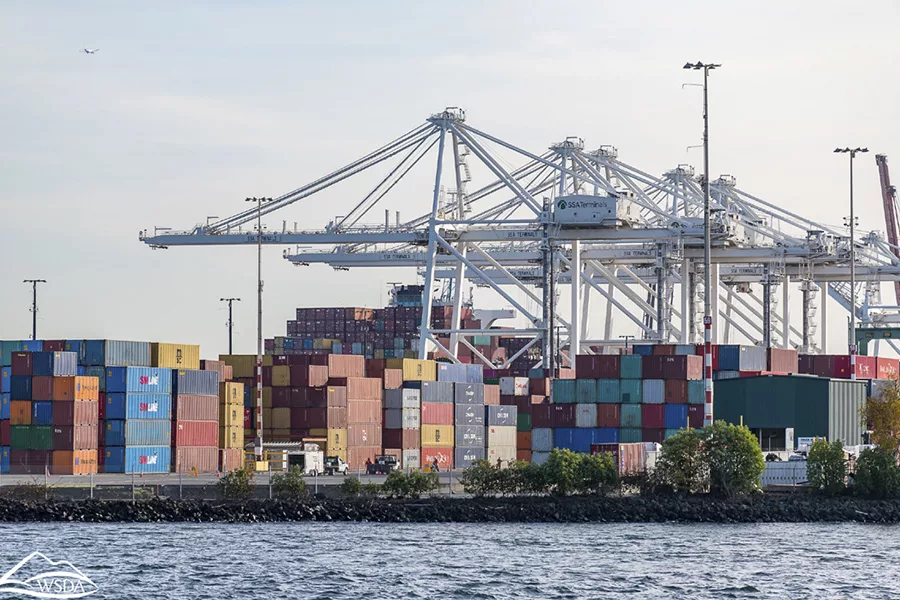
Home » For exporters, a stable year gives way to uncertainty
Difficulties ahead
For exporters, a stable year gives way to uncertainty

Cargo containers sit stacked up on the docks at the Port of Seattle. Billions of dollars of Washington agricultural products are shipped internationally every year and the volatile trade environment in the first part of 2025 has caused uncertainty among many in agriculture.
Courtesy Washington State Department of AgricultureJune 12, 2025
2024 was a stable year for Washington state’s agricultural exports.
While still below the highs of 2022, the total value of products exported from the state’s farms, orchards, vineyards and ranches inched up slightly to $7.6 billion, according to the state Department of Agriculture. Some commodities saw declines, but many from the Mid-Columbia, such as apples, wheat and processed potatoes, remained stable or grew.
Trade relationships were largely unchanged, with Canada remaining the No. 1 destination for much of the state’s agricultural products. However, China fell from the state’s No. 3 export market to No. 4 and Mexico has replaced it.
“Asia will continue to be a major region for us but there has been more focus on our neighbors here,” said Rianne Ham, manager of Department of Agriculture’s international marketing program.
All signs pointed to 2025 maintaining the same trajectory.
But that all changed in early March, when the Trump administration began implementing tariffs on many goods imported from other countries, which responded with retaliatory tariffs. Lawsuits quickly followed and it remains unclear what the ripple effect will be.
Now agricultural exports to China are down 36% compared to this same time last year, Ham said in mid-May. Washington wines have been pulled from shelves in Canada. And exporters who do have goods to deliver are scrambling to find ships as few are showing up to the state’s ports.
While the reality on the ground continues to change daily, Ham and others say it’s not possible to estimate how the current tariff environment may affect the state’s agricultural industry, in the short or long term.
“Regardless of whether the (Trump) administration ultimately imposes the full reciprocal rates or keeps a 10% universal baseline for most countries, the … tariffs will create significant costs for businesses and consumers in Washington state,” according to a paper from the Washington Council on International Trade (WCIT).
Value of exports
The total value of all food and agriculture exports shipped to foreign countries via Washington state’s ports was about $19 billion in 2024, a slight increase from the prior year. State-produced exports alone accounted for $7.6 billion.
Frozen french fries, a major product of the Mid-Columbia, remained the state’s top agricultural export, valued at $1.1 billion. That was an increase of 2.9% compared to the previous year.
Two other Mid-Columbia staples – apples and cherries – saw the most growth. Exporters shipped $845 million worth of apples during the 2024 calendar year, up 24% from the year prior. Fresh sweet cherries came in at $293 million, also a 23% increase, which also benefited from good prices and a better-than-expected crop yield, Ham said.
Canada was a top destination for both those crops, with Mexico being the No. 1 importer of the state’s apples
“(The Washington Apple Commission) has been putting more effort in Mexico and Canada, as has the state,” Ham said of the market expansion.
Even though China dropped from being one of the state’s top three export markets, it still is a significant destination, as just under $700 million in agricultural products from Washington were sent there in 2024, with hay, beef, fish/seafood and cherries being the primary exports.
Among the positive developments in the wake of Trump’s tariff war was the lifting of retaliatory tariffs implemented on the U.S. by India during Trump’s first term. Those tariffs had tanked India as a market, which had previously bought a lot of apples, Ham said, but some exporters began to send shipments there once again.
Uncertainty abounds
Ham summed up the first quarter of 2025 with one word: uncertainty.
There was some anticipation that Trump would implement tariffs once in office, Ham said, so many exporters saw big numbers in January and February as markets sought to get ahead of them. But since they began being implemented in early March, shipments have dropped precipitously as other nations instituted their own in response.
Trade and economic experts say this is an expected outcome.
“History demonstrates the path to trade restrictions is littered with unintended consequences,” said Lori Otto Punke, WCIT president, in a statement. “Consumers face higher prices as they are already reeling from inflation. Innovative manufacturing firms employing Americans in rural areas are squeezed as supply costs increase. Our technology leaders face taxes and restrictions for being innovative and successful. Our farmers, feeding the world, watch as whole markets are closed.”
Ham warned that the current tariff environment isn’t just affecting producers’ bottom lines. “Not only do you have some retaliatory tariffs but there’s a lot of ill will,” Ham said. “What will be the long-term impact of that?”
And because the tariffs have reduced the amount of goods being imported to the U.S., she said, there aren’t enough barges arriving that can leave with Washington state products. Many outgoing shipments are being canceled or can’t be scheduled to begin with, even as some tariffs have eased.
“It sounds like it’s going to take five to six weeks to get things regular again now that China tariffs have been scaled back,” Ham said in mid-May.
Tariff impacts
Many agriculture groups have expressed concerns about the impact of tariffs.
The Washington Grain Commission and Washington Association of Wheat Growers are continually monitoring the situation, noting in statements that tariffs could “undermine decades of market development investments by U.S. wheat farmers.”
“With over 90% of Washington wheat exported, any disruption in shipping capacity or increase in costs could threaten market competitiveness and depress farm prices,” the organizations said in a statement.
But some are not opposed to them.
Potato farmers are seeing potential positive trade developments as a result of the tariffs, said Chris Voigt, executive director of the Washington State Potato Commission, in this Focus edition. Specifically, the industry has sought to get fresh potatoes to Japan for years, but the country’s trade representatives kept holding back.
“But now, our administration has threatened Japan with some pretty good-sized tariffs and they are now at the table negotiating,” Voigt said. “So, we might get fresh potato access to the country.”
Ham noted that some asparagus and blueberry farmers in the state say tariffs can help protect them from being undercut by cheaper foreign imports. The Capital Press reported that the Washington Red Raspberry Commission also supports tariffs.
“Farmers need close to $2 a pound, but Mexican berries are being offered at 60 cents to $1.20 a pound, depressing prices for Washington to $1.75 a pound, according to the commission,” the Capital Journal reported.
Ham said trade representatives for Vietnam have approached the federal government to say they are willing to drop their agricultural tariffs as part of negotiations.
While it remains to be seen whether current tariffs yield better trade agreements in the long term, Ham said many producers aren’t sure they will be around long enough to benefit.
“I think a lot of them feel this is more on top of challenges they already have,” she said. “It’s just becoming very difficult to farm in the state of Washington already.”
Agriculture + Viticulture
KEYWORDS June 2025
Related Articles
Related Products





